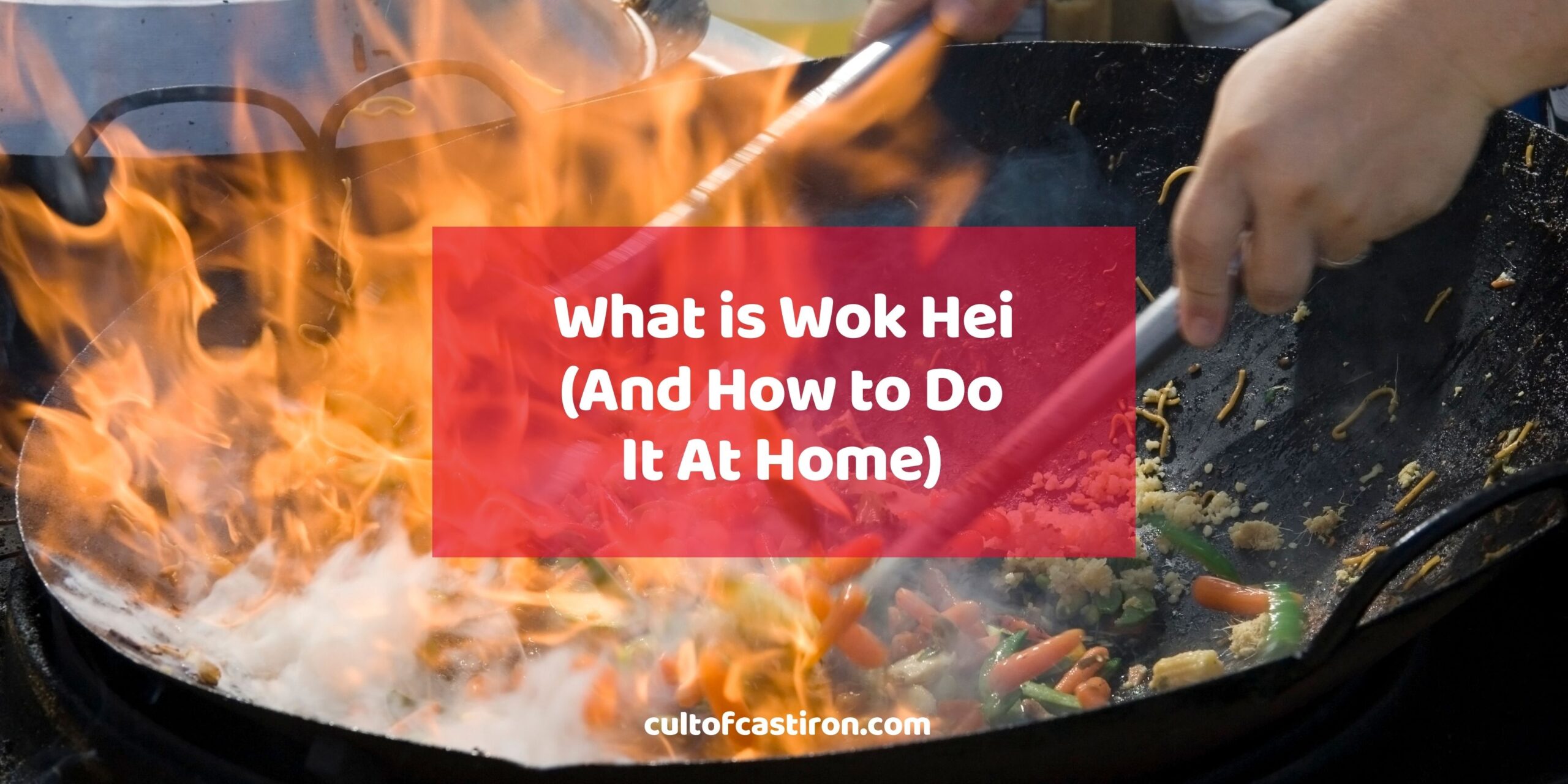Chinese cuisine (or more specifically, Filipino-Chinese cuisine) will always have a special place in my heart. Luckily for me, Binondo, the world’s oldest Chinatown, is only a bus ride away. Apart from that, there are many Chinese restaurants serving Cantonese and Fujian cuisine scattered around my town. There is just something about the salty, oily, and smoky combination that warms my heart. The smokiness plays a big part in these dishes, and this is achieved with a technique called Wok Hei.
Wok Hei, literally translating to ‘the breath of the wok,’ is a quintessential element in Chinese culinary tradition, bringing a unique, smoky aroma to stir-fried dishes. This elusive quality is highly sought after, often considered the hallmark of skill in Chinese cooking. While this technique is mostly seen in restaurant settings, it can be achieved at home with the right knowledge, and more importantly, the right equipment.
This article demystifies the Wok Hei technique, offering practical steps to infuse your home-cooked meals with this authentic, smoky essence. We’ll explore what Wok Hei truly means, the essential tools required, and a detailed breakdown of the technique, enabling you to bring a taste of professional Chinese cuisine into your kitchen.
What is Wok Hei
Wok Hei, also known as breath of the wok and wok energy, refers to the complex charred aroma and taste imparted to food by a well-seasoned and properly heated wok. It’s a hallmark of Cantonese cuisine and other Chinese stir-fries.
The science behind it revolves around the Maillard reaction, where amino acids and reducing sugars react under high heat to form new flavors and aromas. With that said, it’s not all about the high heat applied to the wok itself. You really have to singed the ingredients using flames, almost like flambé, but with oil, not alcohol. The flames that lick the wok’s surface contributes to the smoky flavor that this technique is famous for.
Achieving good results with this technique depends on the cook’s ability to stir fry quickly and efficiently, keeping the ingredients moving constantly to avoid burning, yet cooking them thoroughly to extract maximum flavor. It’s not something that can be easily replicated with low heat or different cooking methods.
What Do You Need To Perform the Wok Hei Technique?
At its core, the Wok Hei technique only demands two pieces of equipment: a wok and a high output burner. Let’s discuss these in-depth
Wok
The traditional round-bottomed carbon steel wok is preferred for this technique. Flat-bottomed woks tend to have most of the heat concentrated at the base of the wok. This can cause food to burn easily, especially with the high temperatures involved in this technique. In contrast, round-bottomed woks spread the flames around the diameter of the pan,. Moreover, its round bottoms make it easier to achieve the circular motion needed for wok tossing.
As for material, carbon steel is the preferred choice because it is a great heat conductor, has non-stick properties due to its seasoning, and it light enough to make tossing easy. While cast iron woks do have similar non-stick properties, they are extremely heavy and thus make tossing unwieldy. Non-stick coated woks are a thing, but the high temperature may degrade the Teflon coating quickly. Meanwhile, aluminum and stainless woks just cause a lot of sticking.
High Output Burner
A high-powered gas stove is ideal for achieving the intense heat required for Wok Hei. Chances are, your typical kitchen range won’t be enough for the job. Most kitchen ranges have about 10,000 to 20,000 BTUs. Wok burners? Up to 150,000 BTUs. Moreover, commercial wok burners typically have a fan that essentially turns the burner into a furnace, which explains its jet-engine like appearance.
Unfortunately, you cannot replicate the results of this technique without a high output burner. You can still make Chinese-style stir fried dishes with regular burners, but you won’t get the Wok Hei flavor that you’re looking for. Here are some alternatives that I can think of:
- Purchase an outdoor wok burner
- Place a wok ring on top of your burner – it will concentrate the heat, but it necessarily won’t make it hotter.
- Make rocket stove, then point a fan through the vent to mimic commercial wok burners.
J. Kenji Lopez-Alt also suggest doing the “Torch Hei” as an alternative. Basically, it mimics the “fire kissing” of Wok Hei, but using a blow torch. Elegant? No. Traditional? Hell no. Does it work? Yeah, it probably will.
Wok Hei Technique Breakdown
The application of the Wok Hei technique depends on the recipe that you are following. I’ve even watched videos of Chinese chefs saying to “add Wok Hei to the dish”, as if its just another ingredient, at the end of the cooking process. So instead of following a step-by-step process of stir frying, I decided to break down the individual aspects of the technique itself
1. Sequential Cooking
Ever noticed how Chinese chefs put ingredients in the wok only to pour it back out after a few seconds of cooking? That is called sequential cooking. Basically, chefs avoid adding everything all at once to prevent the wok from a significant temperature swing. Moreover, preserves flavor and texture between different ingredients that have varying cook times. Adding ingredients in a specific sequence, based on how long they take to cook, ensures that everything is perfectly cooked – nothing underdone or overcooked.
As for the sequence, it is generally meats first, vegetables, then aromatics.
2. Oil
High smoke point oils, like peanut oil and canola oil, should be your choice for this technique.
At first, you should swirl the oil around the wok to coat it. After that, pour the hot oil away from the wok to another container. You can reuse this one later, but for now, pour another batch of fresh oil into the wok. Do this for each sequence of the cooking process. Don’t add too much oil lest the dish become pan fried. Conversely, don’t put too little oil, as this could diminish the Wok Hei flavor you’re looking for.
3. Heat Control
The level of heat control ultimately depends on the type of dish you are making. Some start at a setting to allow meats to soften, while some start screaming hot. Whatever is the case, when it comes time to “add the Wok Hei“, you need to crank the temperature up to until the flames can “kiss” the food as you toss it.
4. Tossing
Tossing is a great way to keep the ingredients moving to prevent them from burning. This is not just a culinary flare – lifting and tossing the ingredients allows them to come into brief contact with the air and flames, enhancing the smoky flavor characteristic of Wok Hei.
A lot can be said about the proper technique for wok tossing, and thus much of the specifics will be left out of this post. Here’s what physicists have to say about the necessary motions needed to execute wok tossing perfectly. Also, be aware that aerosolized oil particles are likely to ignite as they come into contact with the flames.
5. Final Touches
Add seasonings and sauces towards the end as they may burn if cooked too long. As J. Kenji Lopez-Alt suggests, you should pour liquids down the sides of the wok to impart them with the same smokiness as the rest of the dish. Once poured, stir or toss the ingredients again to ensure that the seasonings are incorporated. After that, you can plate up and enjoy your meal!
Conclusion (200 words)
The pursuit of Wok Hei in home cooking is an adventurous journey into the heart of Chinese culinary tradition. While achieving the perfect wok hei may initially seem challenging, it becomes attainable with practice, the right tools, and a deep understanding of the technique.
And if all else fails, grab a blow torch!
Explore the Cult of Cast Iron blog for helpful tips and insights on cast iron, carbon steel, stainless steel, copper, and aluminum cookware. Enhance your cooking skills and take your culinary adventures to new heights.

Miguel is a cast iron enthusiast from Cavite, Philippines. He works in the digital marketing field as a content marketing strategist. On the side, he manages a small online bookstore and tends to his plants.


I’ve learned that you CAN achieve ‘wok hei’ without a high output burner, Indeed, if you have a Weber kettle grill you can do it. Simply light a full chimney starter of LUMP charcoal and dump it in the center of your grill. Then lay a carbon steel wok directly on the coals. It will heat up very hot and very FAST and you will want to use a protective glove to hold the wok above the coals if it starts to get too hot. Then, start your dish! By letting some of the oil drip up over the side of the wok as you flip your food in the bowl soem of the food will get a bit singed and you will get some flame around the edges of the wok and THAT will give you the elusive ‘wok hei’ flavor in your food. It’s not easy to master and I’ve done it a few times and you DO have to be careful but it works!